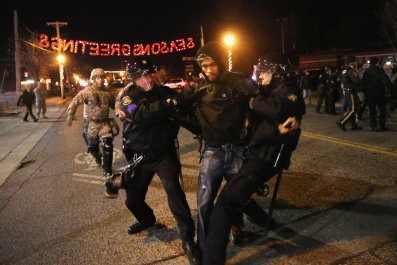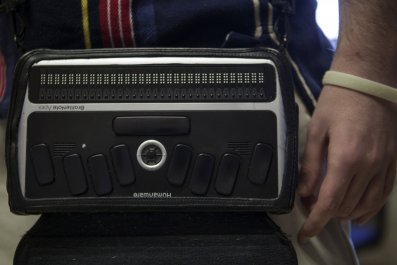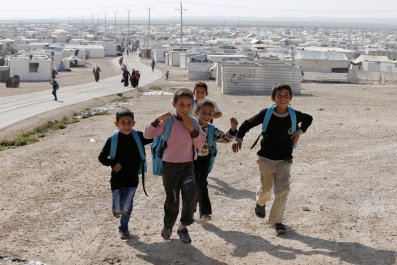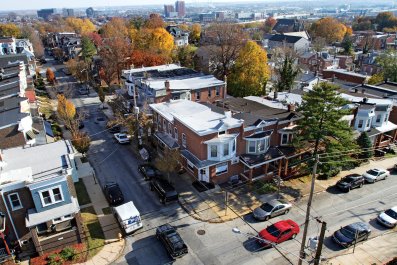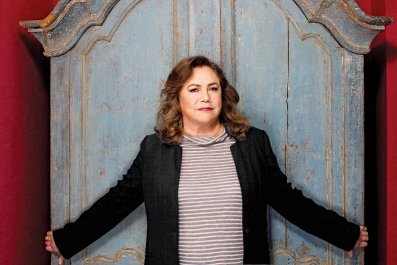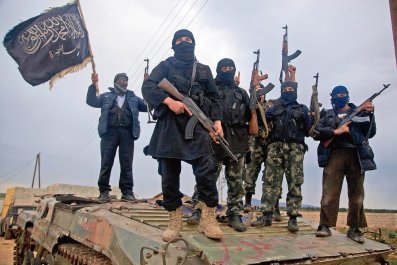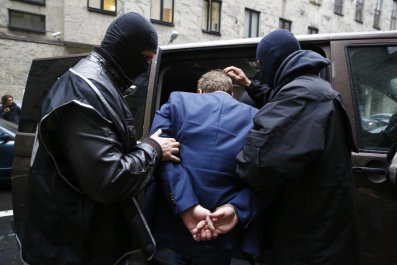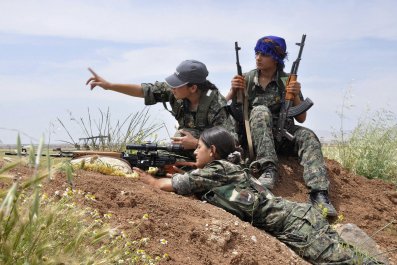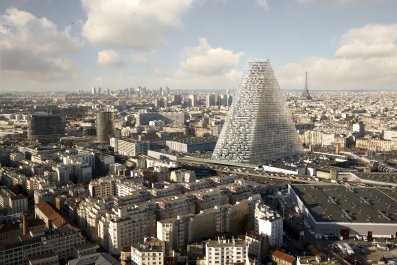On the rare occasions when ISIS leader Abu Bakr al-Baghdadi is seen in public, his entourage is somewhere between that of a president and a mobster. "The minute he entered, the mobile coverage disappeared," says a 29-year-old resident of Raqqa in Syria—who asked to be identified only as Abu Ali—recalling the flawless security on one occasion when al-Baghdadi entered a mosque. "Armed guards closed the area. The women were sent upstairs to the women's section to pray. Everyone was warned not to take photos or videos. It was the most nerve-racking atmosphere.
"What made it [more nerve-racking] is that when Baghdadi finally showed up, wearing black, head to toe, the guards started shouting, 'Allah akbar! Allah akbar!' [God is great.] This made us even more scared," says Ali. "The guards then forced us to swear allegiance to him. Even after Baghdadi left, none of us were allowed to leave the mosque for another 30 minutes.
"He has the working mentality of a Mafioso," says Ali. "He expects his soldiers to be highly disciplined. He's a great war planner, he's very organized."
In his hometown of Samarra, in the Sunni Triangle north of Baghdad, al-Baghdadi, whose real name is Ibrahim Awwad Ibrahim Ali al-Badri and is sometimes known as Abu Awad or Abu Dua (Dua is the name of his eldest daughter), is remembered rather differently. He was always known "for being so quiet you could hardly hear his voice," says a former neighbor, Tareeq Hameed. "He was peaceful. He didn't like to chat a lot."
Acquaintances of the mastermind behind ISIS, which now controls a self-proclaimed caliphate in parts of Iraq and Syria, say he grew up studious, pious and calm. He was introverted, without many friends.
Hameed remembers him as a boy riding a bike, wearing the usual Iraqi male robe, a dishdasha, with a small white cap on his head. "He always had religious or other books attached on the back of his bike, and I never saw him in trousers and shirt, like most of the other guys in Samarra. He had a light beard, and he never hung out in cafés. He had his small circle from his mosque."
Reported to have been born in 1971 in Samarra, al-Baghdadi (the name is an affectation; he does not hail from Baghdad) comes from the Al-Jibriya district, a lower-middle-class neighborhood dominated by the Albu Badri and Albu Baz tribes. It was also an area heavily affected by U.S. bombing after the 2003 invasion of Iraq, an attempt to root out insurgents and terrorist cells.
Al-Baghdadi's family was not wealthy, but two of his uncles worked for Saddam Hussein's security forces. This meant they would have had some status and connections, which would have inspired a certain reverence or fear in the community. "He was from a poor but well-mannered family," says Hashem, a translator from the area who knew the family. "He was someone very introverted…go the mosque, study, read books, that's it."
Al-Baghdadi grew up only a mile away from the 10th century shrine of Imam Hassan al-Askari, one of the holiest sites for Shiite worshippers, but also a place of importance for Sunnis in Samarra. According to the ISIS propaganda machine, faith played a big part in al-Baghdadi's early life, and another Samarra resident, Yessir Fahmi, says al-Baghdadi's childhood was mainly spent attending religious courses. "Ibrahim was, like most of his family, a devoted Muslim," Fahmi says.
But London-based Iraqi analyst Sajad Jiyad from the Iraqi Institute for Economic Reform says he has seen no convincing evidence of such early religious fervor. "I would be surprised if he was a religious person, as most of the Iraqis who became involved in jihadist groups were secular Baathists before 2003," Jiyad says.
Aside from his religion, locals say, al-Baghdadi liked sports, mainly soccer, which he played in a field near his home. "He would rarely get upset during a match, even if you crashed into him or misbehaved with him," recalls Hameed. "He was a good defender. It was hard to pass him and score a goal against his team."
ISIS websites indicate that in these early years, al-Baghdadi studied the Koran at Samarra mosques and took courses in Islamic science and the Hadith—the traditions, deeds and sayings of the Prophet Muhammad. One neighbor says al-Baghdadi was supervised by two prominent clerics (now deceased): Sheikh Subhi al-Saarai and Sheikh Adnan al-Ameen.
There are disputes about al-Baghdadi's early career as a preacher. Some sources say he preached at the Ahmad ibn Hanbal Mosque in Samarra, as well as the Great Mosque in Baghdad, at Friday prayers. But Jiyad and others believe this is just questionable ISIS lore designed to show his superior piety.
More likely is that after high school, as a young man coming of age under Saddam's rule, al-Baghdadi would have had to do compulsory military service in the Iraqi army. Certainly, he would have learned to use a gun in that time and was schooled in basic military tactics.
Around the age of 18, al-Baghdadi first went to Baghdad to study, settling in the Adhamiya district. The depth of his education is also disputed. Some, such as Hameed, say he acquired a Ph.D. in religious studies. No family members are left to contact to confirm that. "Most of his family members have left Samarra in fear of being associated with him," says Fahmi. "Ibrahim left in 2003 to study in Baghdad. His young nephew was arrested last year by the Iraqi security forces. When the last of his family went to Baghdad to negotiate his release, they were arrested, too."
As far as Fahmi knows, al-Baghdadi has not been back to Samarra since 2003.
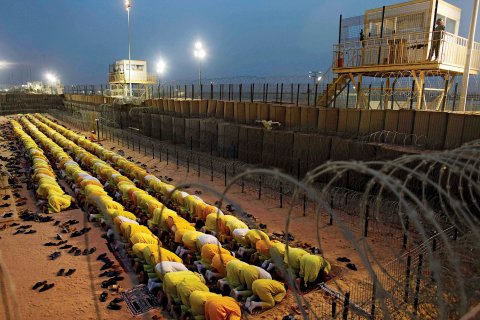
LinkedIn for Terrorists
The origins of al-Baghdadi's ruthlessness lie in the bloodshed unleashed after the U.S. invasion to topple Saddam. American forces rolled into the heart of Baghdad on April 9, 2003. Not long after, the country descended into anarchy. Saddam and his henchmen went into hiding immediately, some heading to villages near the Sunni Triangle, others crossing into Syria. The Sunni insurgents who stayed began their deadly attacks, initially targeting U.S.-led forces.
It is believed al-Baghdadi helped establish the terrorist group Jamaat Jaish Ahl al-Sunnah wal Jamaa. In either 2004 or 2005—like most things about al-Baghdadi, the dates are unclear—he was captured in Fallujah by U.S. forces, apparently part of a sweeping roundup to capture an associate of the Jordanian terrorist Abu Musab al- Zarqawi. Al-Zarqawi, the mastermind of Al-Qaeda in Iraq who was responsible for numerous bombings and deaths, was killed by U.S.-led forces in 2006.
After his arrest, al-Baghdadi was detained in Camp Bucca, a facility in southern Iraq, near Umm Qasr, where many former Abu Ghraib detainees were also held. His status was that of a "civilian internee," which meant he was linked to a terrorist group but had not been caught actively engaging in terrorist activities.
The exact amount of time al-Baghdadi spent at Camp Bucca is unclear. Some U.S. military officials who worked at the prison remember al-Baghdadi being there between 2006 and 2007; others say he was there between 2006 and 2009. Abu Ibrahim al-Raqqawi, a Syrian activist, told Newsweek al-Baghdadi was held between January 2004 and December 2006. Middle East Forum researcher Aymenn Jawad al-Tamimi says that al-Baghdadi's activities in 2005 indicate he must have been released in late 2004.
Whether he spent one or two years there, it was a fruitful time for him. Camp Bucca was like a summer camp for ambitious terrorists. Under the eyes of the Americans, the inmates interacted, traded information and battle tactics and made important contacts for the future. They were inspired by the abuses at Abu Ghraib, the success of al-Zarqawi and the discontent among Sunnis. Historian Jeremi Suri calls the prison "virtual terrorist university."
"Camp Bucca was a place where a lot of jihadists got to know each other and a lot of former Baathists radicalized and linked up with Islamic groups," says Aron Lund, editor of the Syria in Crisis website. "Lots and lots of Islamic State leaders passed through here."
Jiyad says it's unlikely al-Baghdadi was an active militant prior to the U.S. invasion, and he believes Camp Bucca was a turning point for al-Baghdadi. "It would have been an opportunity for him to build his new career as an insurgent," he says. One of al-Baghdadi's contacts from his time in Camp Bucca was Taha Sobhi Falaha, also known as Abu Muhammad al-Adnani, the spokesman for ISIS.
Following his release from Camp Bucca, al-Baghdadi resumed his militant activities. In 2006, an umbrella group of terrorist factions, including Al-Qaeda, formed the Islamic State in Iraq, which al-Baghdadi joined. He was appointed the organization's leader in May 2010.
From the beginning, the Islamic State in Iraq had vast ambitions and a different agenda from Al-Qaeda. It abandoned the Al-Qaeda flag, choosing a new one.
Media site al-Monitor dates the split from the group's gradual disengagement from Al-Qaeda leaders in Afghanistan and its search for separate funding sources. "Then, in mid-2013, Abu Bakr al-Baghdadi announced the establishment of the Islamic State of Iraq and al-Sham [now commonly known as ISIS] and rebelled against the orders of Ayman al-Zawahri, the leader of the international Al-Qaeda organization. Al-Zawahri wanted ISIS to be only active in Iraq and have Jabhat al-Nusra be Al-Qaeda's representative in Syria."
One ISIS defector, who spoke to Newsweek using only the name "Hussein," says he was with al-Baghdadi at the tense time of the break with al-Nusra, the Al-Qaeda affiliate working inside Syria. He recalls the paranoia and mistrust in those meetings, held somewhere in the nebulous border area of Syria and Turkey. "Al-Baghdadi met with [these] men in a separate room in a trailer near the Turkish border," he says. "He would only introduce himself to top-level commanders. The minor ones, he did not introduce himself to. But what was interesting was that in a large group, no one was sure which person in the room was really him. He wanted it to be confused."
Hussein says al-Baghdadi relied heavily on the advice of the late Haji Bakr, a senior ISIS leader and former Iraqi army officer, who was killed in January 2014. According to Hussein, his death was a major blow to al-Baghdadi. "Haji Bakr polished the image of al-Baghdadi—he was grooming him to be the prince of the Islamic State. But to be honest, Haji Bakr was the real prince of the shadows." Al-Baghdadi still relies on a loyal inner circle of military experts and operational security experts. Many of them are people he met in Camp Bucca.
Quiet and Paranoid
Little is known about al-Baghdadi's personal life, except that he is "ruthless in his dealings and quiet in person," says Jiyad. "Paranoia dictates his behavior and routine."
Most mentions of al-Baghdadi on social media are sparse and rarely tell much about his exploits or personality. ISIS-affiliated social media accounts mostly refer to al-Baghdadi when convincing new users to swear bay'ah (allegiance) to the khalifa (caliph).
Al-Baghdadi changes his locations often, most likely crossing the porous border between Iraq and Syria and probably staying in or near Raqqa. Jiyad says he probably lived in Baghdad and Mosul before he fled to Syria with ISIS around 2010. "But very few people got to meet him in those days, and those who did saw him wearing a mask," Jiyad says. "His predecessors and peers were killed using tip-offs and intelligence. But I think he also used the period 2010-2014 to beef up his religious knowledge and to build an aura of mystery around his character."
Lebanese officials said they arrested al-Baghdadi's daughter and ex-wife in early December, though there remains some confusion over their exact relationship to him. CNN reports that the Iraqi Ministry of Interior, citing a source in an intelligence cell under its authority, says al-Baghdadi has two wives, Asma Fawzi Mohammed al-Dulaimi and Israa Rajab Mahal al-Quaisi.
When introducing himself to people, al-Baghdadi covers his face with a scarf and does not allow photographs of himself to be circulated or videos to be distributed widely, like other terrorist leaders, including those of Al-Qaeda. This is also calculated. Jiyad says his earlier photographs, one taken when he was in prison in 2004 and one released by the Iraqi Ministry of Interior—"show an ambitious terrorist, not a caliph."
Jiyad, who has analyzed audio recordings of al-Baghdadi, says they show that his dealings with other terrorist groups, such as Jabhat al-Nusra and Al-Qaeda, "show that he views himself as superior and has a hint of disdain for non-Iraqis."
Above all, says Jiyad, al-Baghdadi seems to be a man who revels in his position "as the world's top terrorist, who sees himself as a successor to Osama bin Laden."
"Once you remove the mystique and grandeur, the 'caliph' turns out to be a rather ordinary man who saw his opportunity and took it," says Jiyad. "He is no different from the hundreds of other Iraqis who attempted to destroy the new Iraq. He could have ended up as a faceless terrorist or a violent criminal. And now he finds himself the center of the world's attention."
- With additional reporting by Omar al-Khani in southern Turkey and Maya Gebeily in Beirut.





